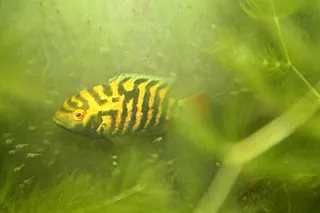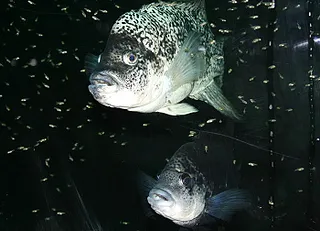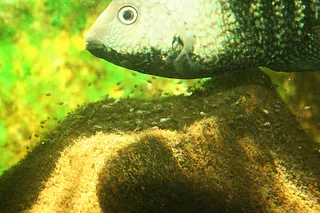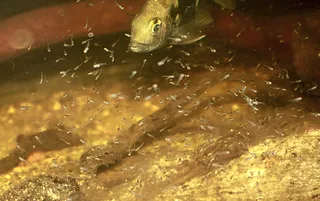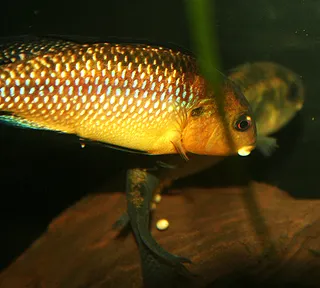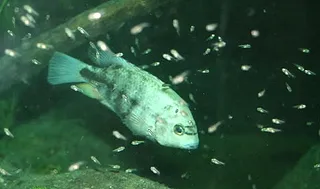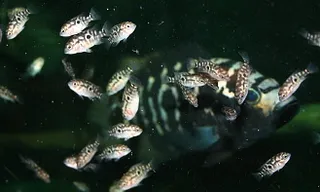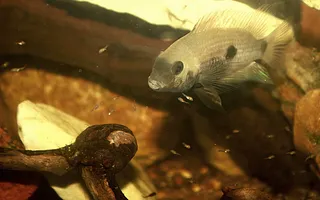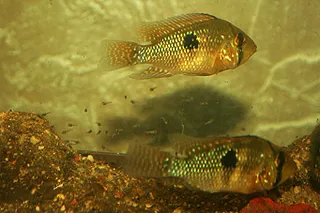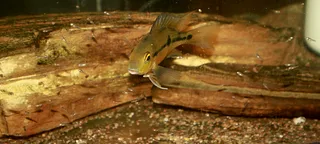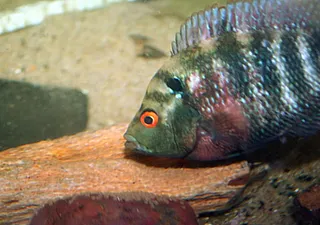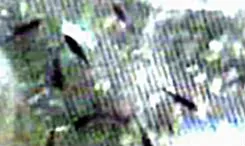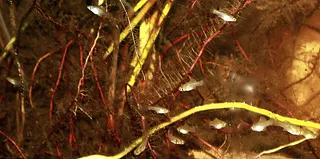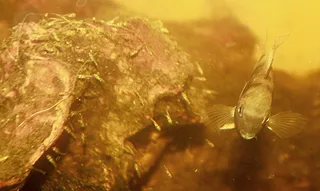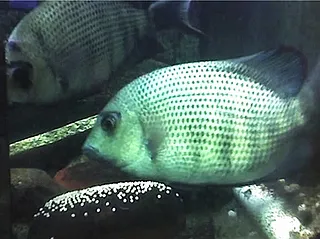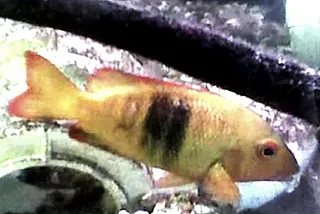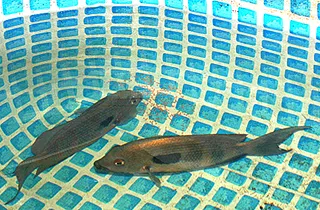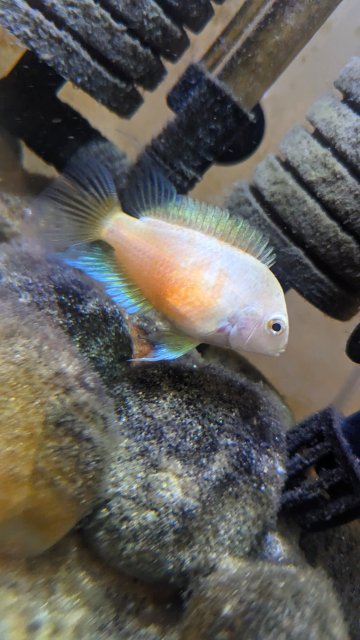I know I've posted lists of things I'm breeding before, but never followed up on which ones were successful. Over these last few years I've only really successfully bred and raised 12 species, but a bunch of varieties of a few of them.
I currently have a colony of limia tridens, consisting of about 30 individuals from 4 different drops, but all from a single female:
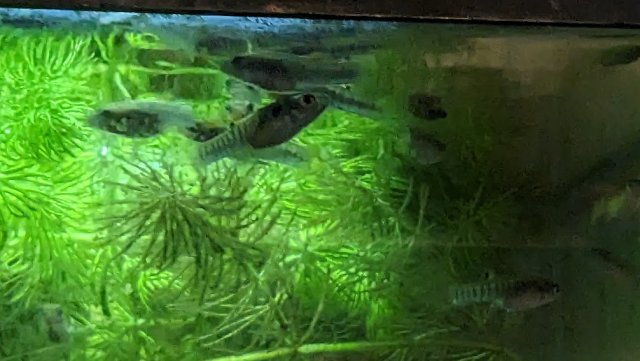


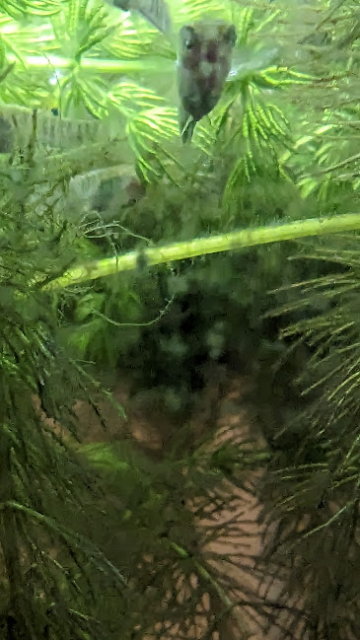
I might also add the current colony is my second generation down from the original group I bought in 2020.
My small (adorable) colony of fireball platies that for some reason came out yellow:
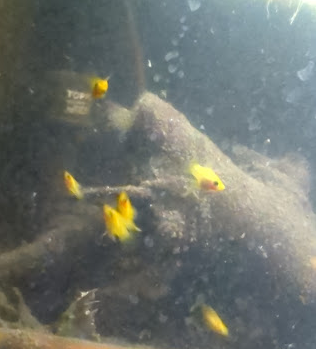

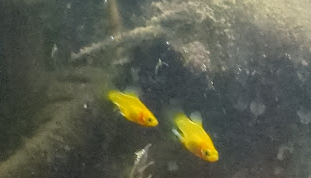
Only first gen, but they've been going for about a year, individuals of varying sizes from 3 different drops. They're all mature and have stopped growing for the most part. Their parents were tiny, I imagine if they're going to grow, they aren't going to get any bigger. Constantly moving, fun to watch.
My colony of "rainbow" convicts:




Some of you may remember these from my "indominus project" in 2020. The original "line" started in 2018 however, and I am now 4 generations in. I call them the "rainbow" colony, just because the genetics of the dominant pair makes their fry come out in 5 different colors. There's mostly black and platinum ones, but there's a few pink and blue ones in there too. The females, as you can see, get very colorful, with very high amounts of orange (or pink in the platinums and blues), with high amounts of blue and green in the fins. Some of them marble, but it's always just a dot on the side, and or a line in the soft rays of the dorsal/anal fins. I do still have my original male as well. He'll be 5 this June. I still see him dance for his (also original) female, and the female dances back, but neither have spawned in about a year. Perhaps the population density in the tank eliminates the need to repopulate. There's probably 3 or 4 batches of their fry and grandkids in there, however. Not the hardest thing to breed, but something I've been breeding nonetheless.
I have spawned my male amatitlania nigrofasciata "rio bagaces" (F1) male about 3 times now, but have only raised one of his batches of fry. He killed his original female, and the second female died from glancing related wounds before I could spawn her again. He also has scars from the glancing of that batch of fry. I've had him for almost 2 years now, and he's about 5". I raised the fry to a sellable size and sold off around a quarter of them, and failed at raising the rest outside. Not sure if it was the heat, or the baby vieja eating them. Anyway I got some of the ones I sold back, so hopefully breeding should resume.


One of his sons is pictured above. For some reason the most recent batch was very high in males; the friend I sold around 30 to (27 made it) ended up with 22 males... to 5 females. Perhaps I should do some tests with pH and temp when raising fry to see if there's any factors that determine sex ratios, like bettas or apistos.
As many of you may know as well, my colony of honduran red points:
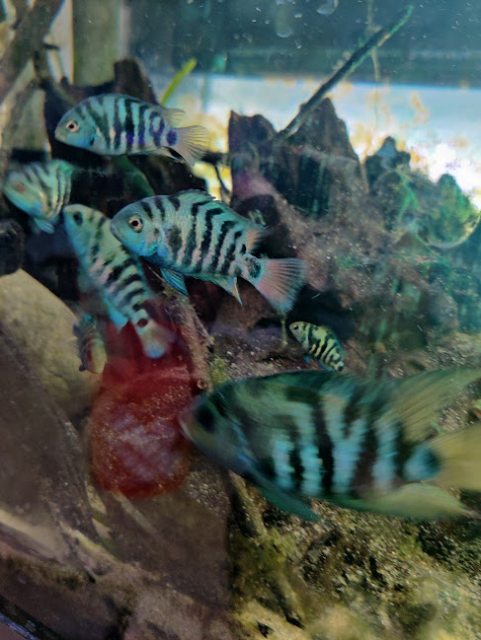
I'm only one generation in, but that batch is about to hit sexual maturity. You can see one of them behind the dominant male in this picture. I currently have around 30, but only intend to keep ~9 of them- just the nicer ones I happen to like. A second batch was born 12/29/21 from the original dominant pair, and the male has decided to court another female. In about a week I'll have two batches of fry from one male, being raised in the same tank.
This is probably my favorite tank, with the 33 long "atlantic costa rica" tank following very closely behind. No heat, no light, just sunlight and 3 filters. I have almost every extant line of honduran red points in here, as I very recently was able to get my hands on the wetspot/Joe Middleton line. I intend to cross all of them back into eachother. There is also the imperial tropicals line which I don't have yet however, and the Jeff Rapps line, which is floating around somewhere (that I may or may not have).
The colony of albino ancistrus I started this year:

They were going strong, I had around 4 batches of fry from 3 females. Started with 1 male to 3 females, eventually got another trio (or quartet, I don't remember). The colony probably ran for around 7 or 8 months, from December 2021 to around June 2022. This is the only picture I could find of them, however. They ended up getting to the size you'd buy them at an LFS, and then the canister's impeller exploded (twice), and they started dying off. Breeding stopped around then, and any "stragglers" were destroyed by the (tiny) sajica I tried growing out in their tank. Most of the breeding adults I ended up selling off, one or two of the females died, and the remaining pair I gave to my dad. Not my highest point in breeding.
In the same tank, I had a colony of gold dust mollies and these red and white platies:
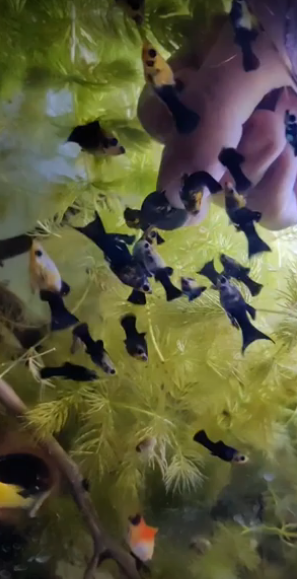

I got 2 generations out of the platies, but only one out of the mollies. Colony had the same timeline as the plecos; they ended up getting demolished by the sajica, and the survivors got thrown in my dad's 55. Most of the platies would come out half red half orange like the one pictured, but sometimes they'd throw out an all white or an all orange one, sometimes with black speckles. The mollies I got to near sexual maturity before throwing them in my dad's tank. The phenotypes of the mollies were interesting as well, the original pair was just normal lyretails, as were most of the fry, but a good portion came out with round tails, and some had these weird super long fins/lyretails, as seen in the first picture near the middle on the right. The biggest surviving male is currently huge, is constantly eating, and has all out brawls with my dad's male myrnae. All of the platies did not make it past the sajica or filter incident.
I had "colonies" of girardinus metallicus (black), poecilia wingei "el tigre", and xiphophorus pygmaeus, and have pictures I will probably post some other time, but can't currently find. I had the girardinus for roughly 2 years and got 2-3 generations out of them, the wingei about a year and got 3 generations, and the pygmaeus I only got one generation from in the year I had them.
I have also been breeding amatitlania nanolutea for the last 3 ish years, only one generation as well, and not a very high number of survivors, but I've had 3 successful batches. The first batch I got to a selling size, sold a few, tried to pull and raise the remainders, only for them to be killed by convict fry I was raising in the same tank. I believe the real second batch never made it past the egg or wriggler stage. The second successful batch however was the biggest, numbering in the hundreds. I also raised most of these fry to a reasonable size. The ones I pulled got outcompeted by hybrid cutteri in the fry tank, but the remaining two are still alive today and owned by my cousin. This was the surviving female last year:
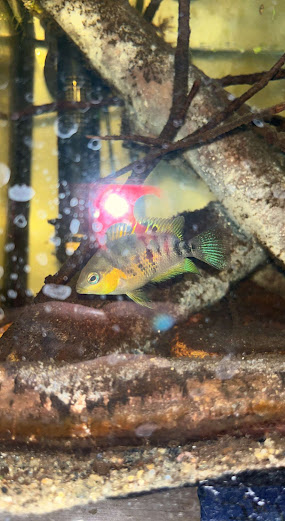
Her and her brother have since doubled in size. Here's the original pair with that batch:
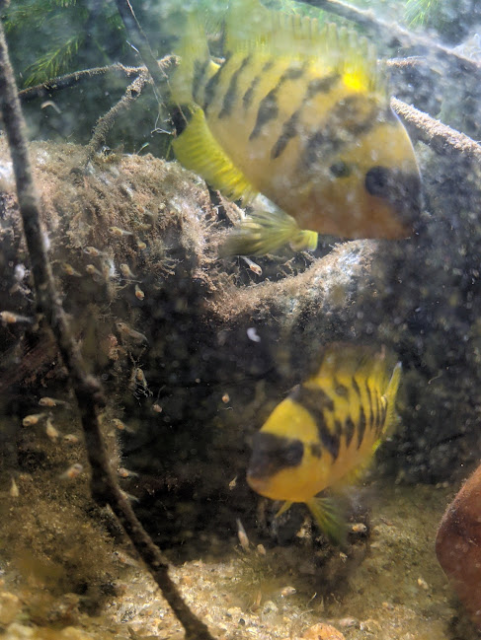

This is also the pair/female that won me photo of the year last year.
They laid an additional batch of eggs while raising this batch, which ended up getting eaten as eggs by the free swimming batch. There were two or three more failed batches between the most recent one, which went extremely poorly by my standards. They laid the eggs in the middle of winter, most of the eggs were infertile and the surviving eggs took roughly a week to hatch, with an additional week and a half to become free swimming. A surprising 30-50 fry made it to the free swimming stage, but slowly died off to around 3 individuals, only one of which is still alive.
That's about it for now. More detailed descriptions of these projects can probably be found in older posts I've made.
I currently have a colony of limia tridens, consisting of about 30 individuals from 4 different drops, but all from a single female:




I might also add the current colony is my second generation down from the original group I bought in 2020.
My small (adorable) colony of fireball platies that for some reason came out yellow:



Only first gen, but they've been going for about a year, individuals of varying sizes from 3 different drops. They're all mature and have stopped growing for the most part. Their parents were tiny, I imagine if they're going to grow, they aren't going to get any bigger. Constantly moving, fun to watch.
My colony of "rainbow" convicts:




Some of you may remember these from my "indominus project" in 2020. The original "line" started in 2018 however, and I am now 4 generations in. I call them the "rainbow" colony, just because the genetics of the dominant pair makes their fry come out in 5 different colors. There's mostly black and platinum ones, but there's a few pink and blue ones in there too. The females, as you can see, get very colorful, with very high amounts of orange (or pink in the platinums and blues), with high amounts of blue and green in the fins. Some of them marble, but it's always just a dot on the side, and or a line in the soft rays of the dorsal/anal fins. I do still have my original male as well. He'll be 5 this June. I still see him dance for his (also original) female, and the female dances back, but neither have spawned in about a year. Perhaps the population density in the tank eliminates the need to repopulate. There's probably 3 or 4 batches of their fry and grandkids in there, however. Not the hardest thing to breed, but something I've been breeding nonetheless.
I have spawned my male amatitlania nigrofasciata "rio bagaces" (F1) male about 3 times now, but have only raised one of his batches of fry. He killed his original female, and the second female died from glancing related wounds before I could spawn her again. He also has scars from the glancing of that batch of fry. I've had him for almost 2 years now, and he's about 5". I raised the fry to a sellable size and sold off around a quarter of them, and failed at raising the rest outside. Not sure if it was the heat, or the baby vieja eating them. Anyway I got some of the ones I sold back, so hopefully breeding should resume.


One of his sons is pictured above. For some reason the most recent batch was very high in males; the friend I sold around 30 to (27 made it) ended up with 22 males... to 5 females. Perhaps I should do some tests with pH and temp when raising fry to see if there's any factors that determine sex ratios, like bettas or apistos.
As many of you may know as well, my colony of honduran red points:

I'm only one generation in, but that batch is about to hit sexual maturity. You can see one of them behind the dominant male in this picture. I currently have around 30, but only intend to keep ~9 of them- just the nicer ones I happen to like. A second batch was born 12/29/21 from the original dominant pair, and the male has decided to court another female. In about a week I'll have two batches of fry from one male, being raised in the same tank.
This is probably my favorite tank, with the 33 long "atlantic costa rica" tank following very closely behind. No heat, no light, just sunlight and 3 filters. I have almost every extant line of honduran red points in here, as I very recently was able to get my hands on the wetspot/Joe Middleton line. I intend to cross all of them back into eachother. There is also the imperial tropicals line which I don't have yet however, and the Jeff Rapps line, which is floating around somewhere (that I may or may not have).
The colony of albino ancistrus I started this year:

They were going strong, I had around 4 batches of fry from 3 females. Started with 1 male to 3 females, eventually got another trio (or quartet, I don't remember). The colony probably ran for around 7 or 8 months, from December 2021 to around June 2022. This is the only picture I could find of them, however. They ended up getting to the size you'd buy them at an LFS, and then the canister's impeller exploded (twice), and they started dying off. Breeding stopped around then, and any "stragglers" were destroyed by the (tiny) sajica I tried growing out in their tank. Most of the breeding adults I ended up selling off, one or two of the females died, and the remaining pair I gave to my dad. Not my highest point in breeding.
In the same tank, I had a colony of gold dust mollies and these red and white platies:


I got 2 generations out of the platies, but only one out of the mollies. Colony had the same timeline as the plecos; they ended up getting demolished by the sajica, and the survivors got thrown in my dad's 55. Most of the platies would come out half red half orange like the one pictured, but sometimes they'd throw out an all white or an all orange one, sometimes with black speckles. The mollies I got to near sexual maturity before throwing them in my dad's tank. The phenotypes of the mollies were interesting as well, the original pair was just normal lyretails, as were most of the fry, but a good portion came out with round tails, and some had these weird super long fins/lyretails, as seen in the first picture near the middle on the right. The biggest surviving male is currently huge, is constantly eating, and has all out brawls with my dad's male myrnae. All of the platies did not make it past the sajica or filter incident.
I had "colonies" of girardinus metallicus (black), poecilia wingei "el tigre", and xiphophorus pygmaeus, and have pictures I will probably post some other time, but can't currently find. I had the girardinus for roughly 2 years and got 2-3 generations out of them, the wingei about a year and got 3 generations, and the pygmaeus I only got one generation from in the year I had them.
I have also been breeding amatitlania nanolutea for the last 3 ish years, only one generation as well, and not a very high number of survivors, but I've had 3 successful batches. The first batch I got to a selling size, sold a few, tried to pull and raise the remainders, only for them to be killed by convict fry I was raising in the same tank. I believe the real second batch never made it past the egg or wriggler stage. The second successful batch however was the biggest, numbering in the hundreds. I also raised most of these fry to a reasonable size. The ones I pulled got outcompeted by hybrid cutteri in the fry tank, but the remaining two are still alive today and owned by my cousin. This was the surviving female last year:

Her and her brother have since doubled in size. Here's the original pair with that batch:


This is also the pair/female that won me photo of the year last year.
They laid an additional batch of eggs while raising this batch, which ended up getting eaten as eggs by the free swimming batch. There were two or three more failed batches between the most recent one, which went extremely poorly by my standards. They laid the eggs in the middle of winter, most of the eggs were infertile and the surviving eggs took roughly a week to hatch, with an additional week and a half to become free swimming. A surprising 30-50 fry made it to the free swimming stage, but slowly died off to around 3 individuals, only one of which is still alive.
That's about it for now. More detailed descriptions of these projects can probably be found in older posts I've made.



